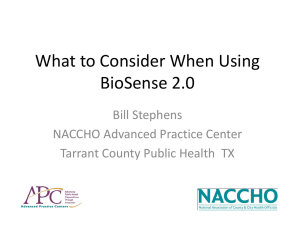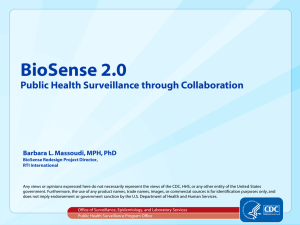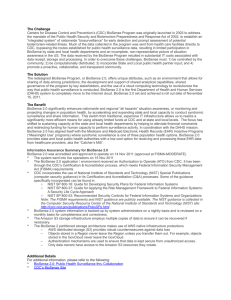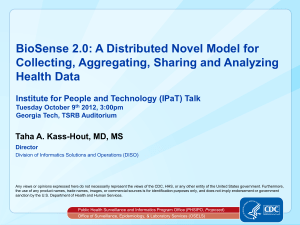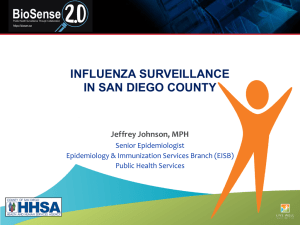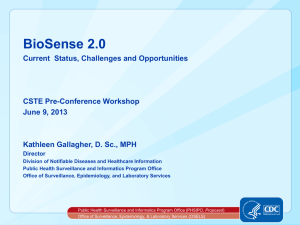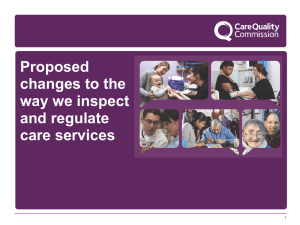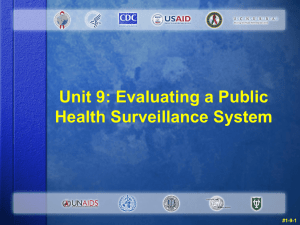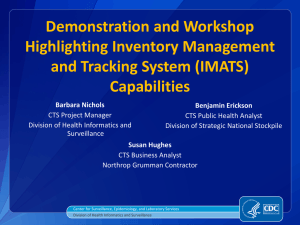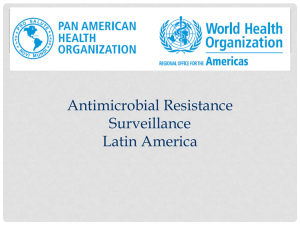Long-Term - Human Factors and Ergonomics Society
advertisement
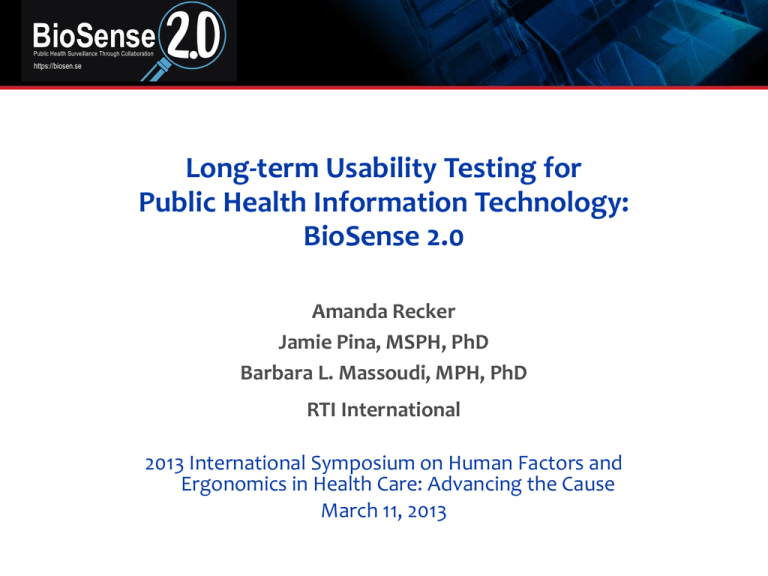
BioSense Public Health Surveillance Through Collaboration https://biosen.se Long-term Usability Testing for Public Health Information Technology: BioSense 2.0 Amanda Recker Jamie Pina, MSPH, PhD Barbara L. Massoudi, MPH, PhD RTI International 2013 International Symposium on Human Factors and Ergonomics in Health Care: Advancing the Cause March 11, 2013 BioSense Public Health Surveillance Through Collaboration https://biosen.se BioSense 1.0: Web-based syndromic surveillance • Mandated in the Public Health Security and Bioterrorism (BT) Preparedness and Response Act of 2002 • Nationwide integrated system for early detection and assessment of potential BT-related illness • 2003 Funding provided by Congress to CDC • Development of BioSense infrastructure started, initial focus on: – VA and DoD – Direct reporting to CDC of detailed clinical data by civilian hospitals • Began soliciting more limited data from health departments (HDs) that had already established automated systems for EDbased syndromic surveillance – By 2007, 8 state/local HDs connected BioSense Public Health Surveillance Through Collaboration https://biosen.se Recommendations from Prior Evaluations • Strengthen state and local public health engagement – Enhance state/local HD syndromic surveillance capacity – Increase participation of state/local HD syndromic surveillance systems (improve coverage) – Share data with HDs from hospitals reporting directly to CDC – Share governance with public health community • • • • • Leverage investments in electronic health records (EHRs) GAO, 2008: Adopt an “open, distributed computing model” Improve utility of the data and data sources Preparedness role: Greater “all hazards” emphasis Expand uses for broader spectrum of public health concerns BioSense Public Health Surveillance Through Collaboration https://biosen.se BioSense 2.0: Timeline • June 2010: Redesign begins • November 2011: Opened for business • November 2011 – June 2013: Onboarding new jurisdictions – 35 jurisdictions signed the Data Use Agreement (DUA) – 17 fully onboarded • April 2012: Retired BioSense 1.0 BioSense Public Health Surveillance Through Collaboration https://biosen.se BioSense 2.0: Approach • Shift from a need-to-know to a need-to-share and co-create approach • User-centered design – Stakeholders engaged in every step of the redesign – HDs fully control “their data” at the level of granularity they choose – More options for data sharing with other jurisdictions and CDC • Alignment with ONC and Meaningful Use – Agreed-upon core syndromic surveillance data elements – Collaborations with public health professional associations – Funding to states: Meaningful Use syndromic surveillance adoption, build capacity, join BioSense 2.0 • Cloud technology: distributed, easy to adopt, cost effective, secure BioSense Public Health Surveillance Through Collaboration https://biosen.se Application Home Page BioSense Public Health Surveillance Through Collaboration https://biosen.se Encephalitis, Meningitis, WNV = CNS Inflammatory Disease BioSense Public Health Surveillance Through Collaboration https://biosen.se Why Long-term Usability Testing? • • • • • Long user-centered design lifecycle Expectation management Stakeholder ownership BioSense 2.0 continuously changing and growing Longitudinal usability testing – User satisfaction – Efficiency • Functions not changing: building a query, viewing results, analyzing the data, sending and saving information • Two approaches to testing BioSense Public Health Surveillance Through Collaboration https://biosen.se 1. User-Centered Design • • • • Qualitative data collection methods The user knows best Test the right participants Broad range of public health professionals – Public health generalist – less sophisticated users – Syndromic surveillance epidemiologist – more sophisticated users BioSense Public Health Surveillance Through Collaboration https://biosen.se 2. Activity-Centered Design • Quantitative data collection methods • Behavior vs. opinions • Based on empirical data – Time-on-task analysis – Mouse-click analysis – Pathway analysis BioSense Public Health Surveillance Through Collaboration https://biosen.se Basic Activities in Interaction Design 1. 2. 3. 4. (Rogers, Sharp, & Preece, 2011) (Rogers, Sharp, & Preece, 2011) Establish requirements Design alternatives Develop prototype Conduct evaluation BioSense Public Health Surveillance Through Collaboration https://biosen.se How to Choose Users • Interact directly with the system – Epidemiologists, state and local public health professionals • Manage direct users – decision-makers – Public health directors • Use similar syndromic applications BioSense Public Health Surveillance Through Collaboration https://biosen.se Generating Design Alternatives • User-centered design – – – – Open question response Focus groups Expectation testing SUS • Expert evaluation – Usability heuristics (Nielsen) • Activity-centered design – Morae software – Scenarios and tasks – Closed/open question response – Time on tasks – Mouse-click analysis – Pathway analysis – Critical incidents BioSense Public Health Surveillance Through Collaboration https://biosen.se Scenarios and Tasks Scenario: “Over dinner at [a public health conference] an argument has erupted, but luckily as a BioSense 2.0 user you can settle this dispute. Health authorities in Virginia suspect that the flu season was more severe than it was in Michigan.” Task: “Please determine which state, Virginia or Michigan, had more cases of influenza-like illness (ILI) starting in October 1, 2010 through March 1, 2011.” BioSense Public Health Surveillance Through Collaboration https://biosen.se Pathway Efficiency Analysis • Time on task • Mouse-click analysis • Pathway analysis BioSense Public Health Surveillance Through Collaboration https://biosen.se Design Alternatives BioSense Public Health Surveillance Through Collaboration https://biosen.se How to Choose Among These Alternatives? • If one person says something is a problem, do you change the design? • Resolved conflicting alternatives • Conducted feasibility analysis • In the end…relied on face validity BioSense Public Health Surveillance Through Collaboration https://biosen.se What Happens After Design Changes? • • • • User training through webinars and videos Expert user testing Focus group sessions Continually comparing SUS scores BioSense Public Health Surveillance Through Collaboration https://biosen.se Future Activities • • • • Incorporate eye tracking into testing protocols Conduct on-site testing and evaluation Task analyses of routine versus event surveillance Information models for routine and event surveillance
